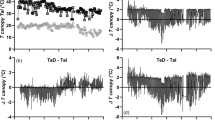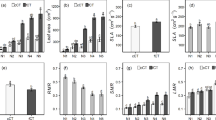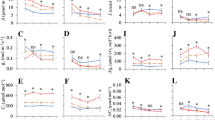Abstract
We evaluated the effects of interacting climate change factors on the morphology, growth, physiological responses, and yield of Kimchi cabbage leaves. Kimchi cabbage was cultivated under two climate change scenarios predicted by the Intergovernmental Panel on Climate Change; Representative Concentration Pathway (RCP) 4.5 and RCP 8.5. For the RCP 4.5 and RCP 8.5 treatments, the air temperatures were maintained 3.4 and 6.0°C above the prevailing control air temperatures and the CO2 concentrations were maintained at 540 and 940 µmol·mol -1, respectively, using newly developed extreme weather growth-chambers. Control plants were grown outside during the autumn. The RCP 4.5 and RCP 8.5 treatments led to tipburn disorders and rough leaves. The light compensation and saturation points of control plants were greater than those of the treatment plants. The maximum carboxylation rate, maximum rate of electron transport, and triose phosphate utilization rate of the RCP 8.5 treatment plants were significantly lower than those of the control. The control plants had the greatest yield among the studied plants, with a 65% reduction in yield observed in the RCP 4.5 treatment plants. The RCP scenarios retarded the growth and assimilation rates, and negatively affected leaf morphology, photosynthesis efficiency, and yield. These results suggest that climate change scenarios may have a profound impact on the cultivation of Kimchi cabbage and that effective mitigation strategies may be needed to ensure that this economically important crop has the necessary resilience under such climate change.
Similar content being viewed by others
Literature Cited
Cho JH, Suh JM, Jin KH, Kang JS, Hong CO, Lim WT, Lee SG (2013) The impacts of high temperature and heavy precipitation amout on winter Chinese cabbage yields. Int J Environ Sci 22:235–242
Choi EY, Seo TC, Lee SG, Cho IH, Stangoulis J (2011) Growth and physiological responses of Chinese cabbage and radish to long-term exposure to elevated carbon dioxide and temperature. Hortic Environ Biotechnol 52:376–386
Chung HD, Choi YJ (2003) Ultrastructural changes in leaves of Chinces cabbage (Brassica campestris ssp. pekinensis) and redicle tissues of radish (Raphanus sativus) grown in high soil EC. J Kor Soc Hort Sci 44:582–587
Clement C, Chavant L, Burrus M, Audran JC (1994) Anther starch variations in lilium during pollen development. Sex Plant Reprod 7:347–356
Crafts-Brandner SJ, Michael ES (2004) Analyzing the impact of high temperature and CO2 on net photosynthesis: biochemical mechanisms, models and genomics. Field Crop Res 90:75–85
Evans JR, Jakobsen I, Orgren E (1993) Photosynthetic light-response curves. 2. Gradients of light absorption and photosynthetic capacity. Planta 189:191–200
Farquhar GD, Caemmerer Sv, Berry JA (1980) A biochemical model of photosynthetic CO2 assimilation in leaves of C3 species. Planta 149:78–90
Intergovernmental Panel on Climate Change (IPCC) (2007) Climate change The Physical Science-Summary for Policymakers. Contribution of Working Group I to the Fourth Assessment Report of the Intergovernmental Panel on Climate Change, p. 17. http://www.ipcc.ch/
Kato T (1981) The physiological mechanism of heading in Chinese cabbage. In: N.S. Talekar & T.A. Griggs (EDS.), Chinese cabbage, Proc. First Intl. Symp. AVRDC, Shanhua, Taiwan, 207–215
Kim KD, Suh JT, Lee JN, Yoo DL, Kwon M, Hong SC (2015) Evaluation of factors related to productivity and yield estimation based on growth characteristics and growing degree days in highland Kimchi Cabbage. Korean J Hortic Sci Technol 33:911–922
Kuo CG, Shen BJ, Chen HM, Opeña RT (1988) Associations between heat tolerance, water consumption, and morphological characters in Chinese cabbage. Euphytica 39:65–73
Lee SG, Lee HJ, Kim SK, Choi CS, Park ST, Jang YA, Do KR (2015) Effects of vernalization, temperature, and soil drying periods on the growth and yield of Chinese cabbage. Korean J Hortic Sci Technol 33:820–828
Lee SG, Moon JH, Jang YA, Kim SY, Ko KD (2009a) Change of photosynthesis and cellular tissue under high CO2 concentration and high temperature in Radish. Korean J Hortic Sci Technol 27:194–198
Lee SG, Moon JH, Jang YA, Lee WM, Cho IH, Kim SY, Ko KD (2009b) Photosynthetic characteristics and celluar tissue of Chinese cabbage are affected by temperature and CO2 concentration. J Bio-Environ Cont 18:148–152
Lee SG, Seo TC, Jang YA, Lee JG, Nam CW, Choi CS, Yeo KH, Um YC (2012) Prediction of Chinese cabbage yield as affected by planting date and nitrogen fertilization for spring production. J Bio-Environ Cont 21:271–275
Ministry of Agriculture, Food and Rural Affairs (MAF) (2015) Primary statistics for agrictulrue production (http://www.mafra.go.kr/main.jsp)
Molas J (2002) Changes of chloroplast ultrastructure and total chlorophyll concentration in cabbage leaves caused by excess of organic Ni (II) complexes. Environ Expt Bot 47:115–126
Morison JIL, Lawlor DW (1999) Interaction between increasing CO2 concentration and temperature on plant growth. Plant Cell Environ 22:659–682
Oh S, Moon KH, Son IC, Song EY, Moon YE, Koh SC (2014) Growth, photosynthesis and chlorophyll fluorescence of chinese cabbage in response to high temperature. Korean J Hortic Sci Technol 32:318–329
Oh S, Moon KH, Song EY, Son IC, Koh SC (2015) Photosynthesis of Chinese cabbage and radish in response to rising leaf temperature druing spring. Hortic Environ Biotechnol 56:159–166
Opeña RT, Lo SH (1979) Genetics of heat tolerance in heading Chinese cabbage. HortScience 14:33–34
Pang W, Kim YY, Li X, Choi SR, Wang Y, Sung CK, Im S, Ramchiary N, Zhou G, Lim YP (2015) Anatomic characteristics associated with head splitting in cabbage (Brassica oleracea var. capitata L.). PLoS ONE 10:1–12
Rodríguez VM, Soengas P, Alonso-Villaverde V, Sotelo T, Cartea1 ME, Velasco1 P (2015) Effect of temperature stress on the early vegetative development of Brassica oleracea L. BMC Plant Biol 15:145–153
Rural development administration (RDA) (2005) Practical manual of Chinese cabbage.
Sage RF, Sharkey TD (1987) The effect of temperature on the occurrence of O2 and CO2-insensitivity photosynthesis in field grown plants. Plant Physiol 84:658–664
Sage RF, Sharkey TD, Seemann JR (1989) Acclimation of photosynthesis to elevated CO2 in five C3 species. Plant Physiol 89:590–596
Sasek TW, DeLucia EH, Strain BR (1985) Reversibility of photosynthetic inhibition in cotton after long-term exposure to elevated CO2 concentrations. Plant Physiol 78:619–622
Schrader SM, Wise RR, Wacholtz WF, Ort DR, and Sharkey TD (2004) Thylakoid membrane responses to moderately high leaf temperature in Pima cotton. Plant Cell Environ 27:725–735
Sharkey TD, Bernacchi CJ, Farquhar GD, Singsaas EL (2007) Fitting photosynthetic carbon dioxide response curves for C3 leaves. Plant Cell Environ 30:1035–1040
Son IC, Moon KH, Song EY, Oh S, Seo H, Moon YE, Yang J (2015) Effect of differentiated temperature based on growing season temperature on growth and physiological response in Chinese cabbage 'Chunkwang'. Kor J Agri Forest Meteorol 17:254–260
Taub DR, Seemann JR, Coleman JS (2000) Growth in elevated CO2 protects photosynthesis against high-temperature damage. Plant Cell Environ 23:649–656
Yin. X, Struik PC (2009) C3 and C4 photosyntheis models: An overview from the perspective of crop modelling. NJAS -Wageningen J Life Sci 57:27–38
Author information
Authors and Affiliations
Corresponding author
Rights and permissions
About this article
Cite this article
Lee, S.G., Kim, S.K., Lee, H.J. et al. Impacts of climate change on the growth, morphological and physiological responses, and yield of Kimchi cabbage leaves. Hortic. Environ. Biotechnol. 57, 470–477 (2016). https://doi.org/10.1007/s13580-016-1163-9
Received:
Revised:
Accepted:
Published:
Issue Date:
DOI: https://doi.org/10.1007/s13580-016-1163-9




